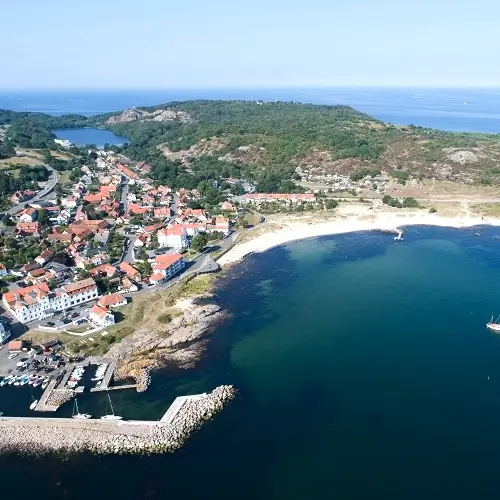
Bornholm is a picturesque island in the Baltic Sea, known for its diverse landscapes – from sandy beaches and dramatic cliffs to forests and scenic heathlands. Its unique nature and numerous hiking trails make it an ideal destination for active recreation and connecting with nature.

Bornholm is a charming island where nature captivates with its diversity. The rocky cliffs of Hammeren in the north contrast with the sandy beaches of the south, creating spectacular views. Its landscape, shaped over thousands of years, is a blend of wild nature and history. Rivers, lakes, and unique ecosystems, protected within reserves, make Bornholm a paradise for nature lovers and those seeking tranquility. An ideal destination for an unforgettable retreat!
The Bornholm Coastline is a fascinating place where nature creates an extraordinary harmony of contrasts. Rugged, rocky cliffs in the north, such as Jons Kapel or Hammeren Cape, showcase the island's majestic beauty. From Allinge to Svaneke, the northern coast captivates with steep escarpments that hide charming sandy beaches and picturesque coastal meadows and marshes adorned with reeds.
In the southern part of Bornholm, the landscape changes dramatically. Vast dunes, covered with fine white sand, stretch for over a kilometer, forming some of the most beautiful beaches in the region. Between Nexo and Dueodde, sandy shores and wetlands enchant with their rich vegetation and tranquility.


Bornholm enchants with its mysterious crevasse valleys, formed thousands of years ago as a result of glacial activity. Features like Ekkødalen and Døndalen are the outcomes of tectonic fractures and erosion, offering unique landscapes. Traces of glaciers, including smoothed granite surfaces and erratic boulders, make up the geological treasures of the island's north. These valleys are a refuge for lush vegetation and wildlife, and a walk in their shadow is an unforgettable experience of Bornholm's natural beauty.
Bornholm's heathlands are a unique feature of the island's landscape, reflecting its cultural past. Formed over centuries of cattle grazing, they once covered a significant portion of the island. Today, their remnants, such as those in Hammerknuden, Paradisbakkerne, and Rutsker Højlyng, are carefully protected and maintained. Particularly remarkable are the Balkalyngen heathlands – the only ones in Denmark situated on sandstone, forming a unique ecosystem. These are places where nature and history intertwine in harmony, offering unforgettable experiences and a wealth of knowledge about Bornholm.


Bornholm, the most forested island in Denmark, captivates with its diverse woodland landscapes. Over 20% of its area is covered by forests, with the largest, Almindingen, ranking as the third-largest forest complex in the country. Situated on rocky terrain, it offers picturesque views that attract nature enthusiasts.
What makes these forests unique? Many were established on former heathlands, serving as a testament to the collaboration between nature and humans. Additionally, Bornholm hides remnants of ancient forests with unique species such as hornbeam and wild cherry, offering unforgettable walks in the wilderness.
The island also features gallery forests stretching along streams and creeks, creating the perfect setting for relaxation.
Bornholm is an island teeming with life and unique species that form a distinctive ecosystem. One of its most fascinating inhabitants is the fallow deer – introduced by humans, it has become an integral part of the island's fauna. Bornholm is also a birdwatcher's paradise, with numerous reserves such as Graesholm and Nexo, where sea and migratory birds can be observed.
The island is famous for its hedgehogs, numerous bat species (including six newly discovered ones), and European bison reintroduced from Poland to restore biodiversity. Reptiles and amphibians, such as the edible frog and species found in the heathlands of Hammerknuden, add charm to the local wildlife.
Bornholm is a place where nature and humans coexist in harmony, offering unforgettable encounters with wildlife and fascinating opportunities to explore its natural wonders.
